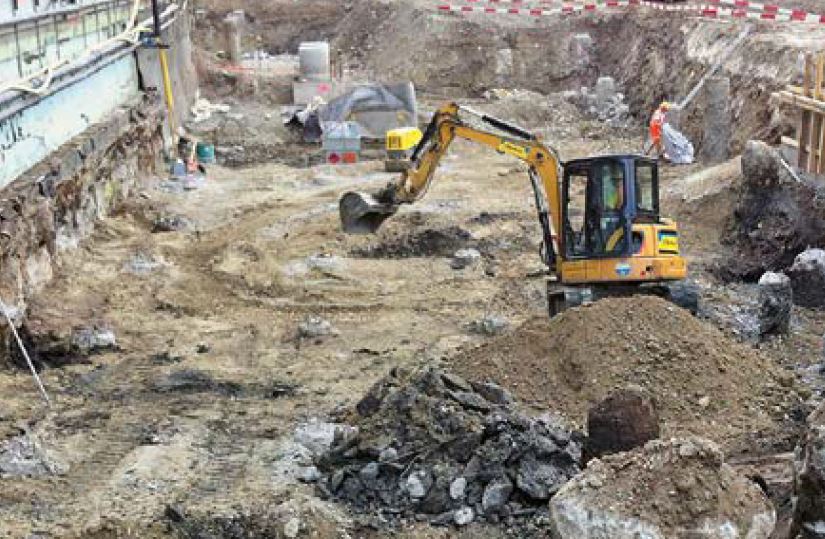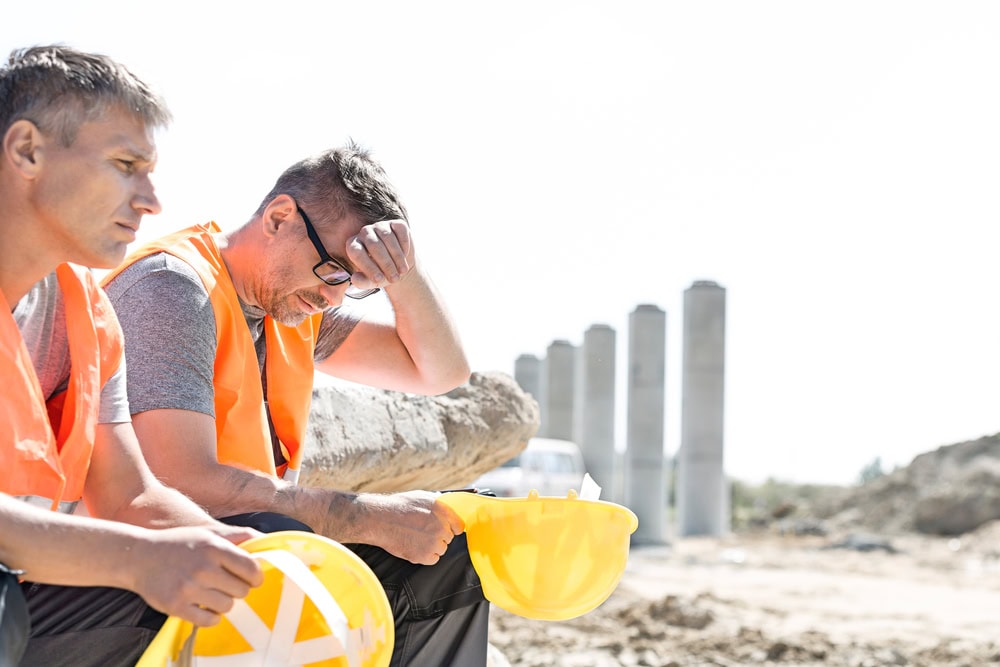Legacy costs can be quite a burden
Anyone who wants to buy or build on a plot of land should take a look at the cadastre of contaminated sites. This protects against unpleasant surprises.

Since 1983, the Federal Law on Environmental Protection has included a section on the remediation of polluted sites. In 1998, this section was revised, the Contaminated Sites Ordinance was enacted, and in 2006, additions were made to the financing of the remediation of contaminated sites.
Contaminated sites, polluted sites and waste
The three terms are closely related. Once contaminated soil or subsoil is excavated, the movement of a single excavator shovel turns a contaminated site or contaminated site into contaminated construction waste. Construction waste must be disposed of at the owner's expense. This is usually the building owner.
Before starting excavation work, building owners are well advised to clarify exactly who will bear the additional costs for the contaminated excavation and whether and what type of remediation may be necessary or has been ordered. This includes, in particular, clarifying whether or not the contaminated site poses a hazard - in terms of air, water, soil. This is because the so-called hazard makes a contaminated site a contaminated site.
The difference is important: in the case of a contaminated site without a hazardous condition, there is no obligation to remediate. In the case of excavation necessary for construction, the costs of the contaminated waste are borne entirely by the developer, who can only claim these costs under civil law or through contracts concluded in advance with the party causing the contamination or the seller of the land. Only in precisely defined cases can Art. 32b bis of the USG be invoked and the polluter be asked to pay for this so-called building owner's waste.
In the case of a polluted site with a potential hazard, we are talking about a contaminated site: the costs are to be borne by the polluter. If the polluter is unknown or insolvent, his share of the costs is borne by the community (canton, public fund, municipality, etc.), whereby such cost bearing is usually preceded by an order prescribing remediation and including a cost sharing order. In this case, the client is exempt from bearing the costs.
Estimation of risks and costs
The cost of contaminated construction waste is primarily determined by the prescribed disposal routes. How must the waste be separated? To what extent is recycling mandatory? Which wastes must be incinerated, which must go to a landfill, and to which landfill? These questions have been regulated since 2015 in the Ordinance on the Prevention and Disposal of Waste.
Therefore, the quantity and type of contaminated excavated material should be known before any construction work is carried out in order to be able to estimate the costs of disposal. How should the risk and cost assessment be carried out? What instruments are available?
This topic will be explored in greater depth at the "Contaminated Sites Intensive" conference in March 2020 (see box at the end of the text), where topics will include the certainty of forecasts and the best way to proceed.
A first step before buying or building on a piece of land is to look at the cadastre of contaminated sites, which is publicly available in all cantons.
Cadastre of polluted sites (KbS): The cadastre is an information and planning tool for authorities, but also helps landowners, prospective buyers and builders. The cadastre always contains the following information:
- Location of the site
- Type and quantity of the existing loads
- Deposition and operation period as well as already determined impacts
- Examinations already carried out
What does a KbS entry mean? There is a high probability of contamination on the property. There have been cases in the past where supposedly contaminated sites turned out to be uncontaminated. For developers or buyers, however, the opposite case is much more serious: if contamination during the construction phase turns out to be more serious than assumed or if land is contaminated that is not listed in the cadastre.
It is up to the buyer or the builder to find out enough information about encumbrances and their costs in advance. If a plot of land is not listed in the cadastre, the following questions should be asked:
- In which area is the property located?
- Are land plots in the neighborhood listed in the cadastre?
- Is it a former industrial, commercial, or landfill site?
- Are there any fills?
- Is it a former gravel mining area?
- Is it in the alluvium of rivers?
Anyone who can answer yes to one of these questions should take a closer look.
If a property is listed in the cadastre, the following question is important: Are the investigations sufficient for a final assessment or does further information need to be obtained?
In theory it sounds simple, but how should the builder proceed? The only advice that can be given here is to call in professionals who can provide the necessary help in answering these questions, in particular the various surveyor's offices and disposal companies that specialize in polluted sites and contaminated sites.
What is not in the cadastre? In the cadastre, only burdens in the subsoil are recorded. Contamination in buildings is not recorded there. Before any work is carried out, the building owner is responsible for inspecting the building for possible contamination with asbestos, PCBs and other hazardous substances, as he is responsible for the health and safety of those working on the construction site. In the event of improper work with contaminated building material, the building owner may be subject to high recourse claims.
Exposure in the building is particularly prevalent in former production facilities and in buildings constructed or renovated in the period between 1950 and 1980. There is virtually no building from this period that does not contain asbestos or PCBs. Here, too, experts can help in assessing the exposure.
Avoiding time pressure: Our research shows that time pressure in particular causes costs to skyrocket.
For the success of building over a polluted site, it is crucial to have the most accurate information possible before purchasing or starting construction. This does not mean that the entire site is dug up as completely and deeply as possible during a technical investigation - but rather that the knowledge of the experts is used strategically and tactically so that the most comprehensive result possible can be achieved with less cost-intensive investigations. More expensive technical investigations can thus be kept to a minimum.
The least expensive investigation is still the historical investigation - it takes time, but often a relatively accurate picture of what used to be on the property can be obtained through old plans, interviewing former employees or neighbors. It makes sense to invest more time and effort in this relatively inexpensive investigation than to jump right in, hoping that things won't be so bad after all. This approach, while human, has driven many a builder to the brink of ruin.
How reliable are forecasts? The more detailed the investigation, the more precisely the loads and the resulting costs are known. But technical investigations in particular are relatively expensive. The cost of technical investigations increases exponentially as the accuracy of the prediction increases beyond a certain point. Consequently, there is an optimum to which investigations should be performed. How can this optimum be determined? This is different for each individual case and can only be illustrated by examples. It depends, among other things, on the type and distribution of the contamination, the nature of the subsoil or when and over what period of time the subsoil was contaminated. There is no patent remedy.
It may be that at this point it makes sense to take a step back in order to deepen the more cost-effective historical investigation, to develop additional sources of information and only then to continue the technical investigations. This can only be assessed by experts, i.e. by expert offices specializing in soil contamination.
In the case of contaminated sites, however, there is always a residual uncertainty; the most detailed investigation cannot bring this risk down to zero. Those who shy away from this risk can, in particular, award the contract for excavation for a lump sum price; there are companies today that have the experience to do this. But beware of black sheep! In the end, it is always the client who bears the responsibility: If the company commissioned by the client does not dispose of the excavated material correctly, the authorities can take recourse against the client.
Optimization of costs by adjusting the planning: Building on polluted sites is possible - but it takes time for good planning and for contingencies. In the previous section, we saw that a good knowledge of the load is crucial for a reliable cost forecast.
However, a precise knowledge of the load allows more: the planning can be adapted to the conditions on site. Every cubic meter of contaminated material that is not excavated does not incur costs in disposal. If the loads are known locally, perhaps the structures can be moved so that no, or at least less, contaminated excavated material is produced. Who knows, maybe moving the building structures can lead to an interesting architectural design. Maybe the underground parking or a basement can be built where there is no pollution. Or is it possible to build upwards instead of downwards?
Involvement of all stakeholders: A shift of the building structures or a higher construction method usually requires the approval of the authorities: Is a shifting of the building structure permissible at all? Does an exception to the distances to be maintained have to be applied for and approved?
Is it possible to achieve with the authorities a higher development than that foreseen in the zone? Can the added value thus created partially cover the costs incurred by the load?
Is there a public interest in the redevelopment? Cities and communities often have an interest in putting brownfields on their territory to new use and may be willing to negotiate. Answering these questions takes time and patience and reaching out to public stakeholders. In this way, new paths can be taken and innovative solutions created that are not possible under time pressure.
Total renovation yes or no? Many developers have the goal of completely removing the contamination on the property, whether by excavation or another type of decontamination (e.g. soil washing). The advantage: The property is subsequently no longer listed in the cadastre and the rental income and the income value are correspondingly higher.
Careful consideration must be given here: Does the additional profit justify the higher costs for such a total refurbishment? Are the necessary costs for a total refurbishment really being used wisely? Or is the net profit, i.e. the difference between the sales price or rental income and the costs of the superstructure, perhaps higher if only as much redevelopment is carried out as is legally required?
Lesser-known cost drivers: What many builders overlook - changes in the law can also drive up costs. There are various examples where the disposal was planned about ten years ago in accordance with the legal requirements, but the construction project was not carried out until more recently for various reasons. In the meantime, new regulations for limit values in waste or newly prescribed disposal routes have increased the costs of disposal by over 100 percent in individual cases. In the event of major delays, all builders are well advised to find out whether the project can still be carried out as originally planned and at the planned cost.
This uncertainty always exists; changes to current practice are also conceivable in the future. For example, the guidelines of the Ordinance on the Prevention and Disposal of Waste are still partly in progress and will only be published in the next few years and may result in changes. Although guidance documents do not have the force of law, the courts often include guidance documents in their decisions in disputes. Therefore, changes to the current practice are also conceivable in the future.
Regulation in contracts
All these issues must be regulated in detail. In the case of contracts with public authorities, the following points in particular must be stipulated: a precise definition of the parties, the exclusion of risk in the case of political changes, and the exclusion of the danger of the undermining of direct democratic civil rights in the light of equality of rights, the prohibition of arbitrariness, proportionality and the submission regulations. Otherwise, the project will not survive the possible objections.
The polluter(s) of the contaminated site or polluted site must also be involved in questions of financing. Who assumes which costs? Does the polluter bear the costs only for the legally required remediation of the contaminated site, i.e. up to the point at which the site no longer poses a risk to soil, water or air? Or does the polluter bear the costs for the total remediation that the developer may want? Many building owners have had a rude awakening in this respect after the contaminated subsoil has been completely excavated and disposed of at great expense.
A contract between private parties must contain all the agreements made in detail, in particular the obligation to bear the costs, the warranty, the exact description of the polluted site and the type and scope of remediation. The contract must not contradict the provisions of the Civil Code and the Code of Obligations and must, in particular, take into account all public law requirements, because public law takes precedence over private law.
Conclusion
The risk involved in building on or purchasing contaminated sites is manageable. Decisive for a successful process are comprehensive information about the contamination, good planning, time for unforeseen events, and the involvement of experts and specialists (suitable consultants, legal advisors, and contractors). Builders who involve these experts and have enough time know the risks, can calculate them and deal with them.
However, if you are afraid of such risks, it is better to award the contract across the board to an expert company. But beware of black sheep, because the responsibility for legally compliant execution always lies with the client.
Author: Gerhard Schneider, Prof. Dr., University of Applied Sciences, and Arts Western Switzerland (HES-SO), HEIG-VD, Yverdon-les-Bains
"Legacy intensive"
At March 17, 2020 Heigh-VD is holding the conference "Contaminated sites intensive: remediation costs - forecast and reality" in Zurich. The following topics are in focus:
- The safe forecast: desire and reality. View of the appraisers and entrepreneurs
- Securing contaminated sites under the law - a now commonplace business in the Canton of Zurich
- How do the cantons deal with the landfill aftercare costs - a practical example
- Do banks decide on the loss of value of encumbered properties?
- How do real estate developers deal with encumbrances on land?
- Current case law and court decisions
For more information: www.umweltrecht-schweiz.ch









